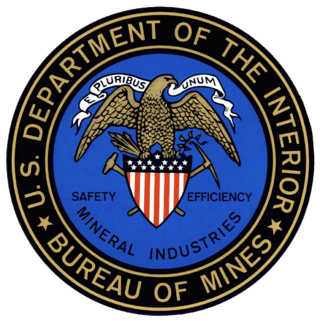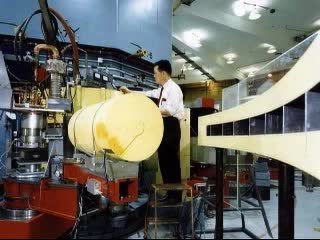Related Research Articles

The National Institute for Occupational Safety and Health is the United States federal agency responsible for conducting research and making recommendations for the prevention of work-related injury and illness. NIOSH is part of the Centers for Disease Control and Prevention (CDC) within the U.S. Department of Health and Human Services. Despite its name, it is not part of either the National Institutes of Health nor OSHA. Its current director is John Howard.

For most of the 20th century, the United States Bureau of Mines (USBM) was the primary United States government agency conducting scientific research and disseminating information on the extraction, processing, use, and conservation of mineral resources. The Bureau was abolished in 1996.

An occupational hazard is a hazard experienced in the workplace. This encompasses many types of hazards, including chemical hazards, biological hazards (biohazards), psychosocial hazards, and physical hazards. In the United States, the National Institute for Occupational Safety and Health (NIOSH) conduct workplace investigations and research addressing workplace health and safety hazards resulting in guidelines. The Occupational Safety and Health Administration (OSHA) establishes enforceable standards to prevent workplace injuries and illnesses. In the EU, a similar role is taken by EU-OSHA.
The US National Institute for Occupational Safety and Health funds the Adult Blood Lead Epidemiology and Surveillance (ABLES) program, a state-based surveillance program of laboratory-reported adult blood lead levels. In 2009, the ABLES program updated its case definition for an Elevated Blood Lead Level to a blood lead concentration equal or greater than 10 micrograms per deciliter (10 μg/dL). This chart shows CDC/NIOSH/ABLES Elevated blood lead level case definition in perspective.
The National Occupational Research Agenda (NORA) is a partnership program developed by the National Institute for Occupational Safety and Health (NIOSH). The program was founded in 1996 to provide a framework for research collaborations among universities, large and small businesses, professional societies, government agencies, and worker organizations. Together these parties identify issues in the field of workplace safety and health that require immediate attention based on the number of workers affected, the seriousness of the hazard, and the likelihood that new safety information and approaches can effect a change.
Prevention through design (PtD), also called safety by design usually in Europe, is the concept of applying methods to minimize occupational hazards early in the design process, with an emphasis on optimizing employee health and safety throughout the life cycle of materials and processes. It is a concept and movement that encourages construction or product designers to "design out" health and safety risks during design development. The process also encourages the various stakeholders within a construction project to be collaborative and share the responsibilities of workers' safety evenly. The concept supports the view that along with quality, programme and cost; safety is determined during the design stage. It increases the cost-effectiveness of enhancements to occupational safety and health.

John Jackson Howard is an American physician, professor, and public health administrator who served a 6-year term as the director of the National Institute for Occupational Safety and Health and was appointed to be a special coordinator to respond to the health effects of the September 11 attacks. In this role, Howard advocated for rescue workers, introducing a program to provide screening, medical exams, and treatment for them. In 2009, Howard was again appointed as director of NIOSH and as World Trade Center Programs coordinator for HHS. In 2011, Howard became the Administrator of the World Trade Center Health Program. In 2016, he became the first person to be appointed to a third 6-year term as NIOSH director, and was reappointed to a fourth term in 2021.
NIOSH Education and Research Centers are multidisciplinary centers supported by the National Institute for Occupational Safety and Health for education and research in the field of occupational health. Through the centers, NIOSH supports academic degree programs, research, continuing education, and outreach. The ERCs, distributed in regions across the United States, establish academic, labor, and industry research partnerships. The research conducted at the centers is related to the National Occupational Research Agenda (NORA) established by NIOSH.
An occupational fatality is a death that occurs while a person is at work or performing work related tasks. Occupational fatalities are also commonly called "occupational deaths" or "work-related deaths/fatalities" and can occur in any industry or occupation.

A physical hazard is an agent, factor or circumstance that can cause harm with contact. They can be classified as type of occupational hazard or environmental hazard. Physical hazards include ergonomic hazards, radiation, heat and cold stress, vibration hazards, and noise hazards. Engineering controls are often used to mitigate physical hazards.

Radiation dose reconstruction refers to the process of estimating radiation doses that were received by individuals or populations in the past as a result of particular exposure situations of concern. The basic principle of radiation dose reconstruction is to characterize the radiation environment to which individuals have been exposed using available information. In cases where radiation exposures can not be fully characterized based on available data, default values based on reasonable scientific assumptions can be used as substitutes. The extent to which the default values are used depends on the purpose of the reconstruction(s) being undertaken.

Buy Quiet is an American health and safety initiative to select and purchase the lowest noise emitting power tools and machinery in order to reduce occupational and community noise exposure. Buy Quiet Programs are examples of noise control strategies. Buy Quiet is part of the larger Hearing Loss Prevention Program, and is an example of Prevention Through Design, which seeks to reduce occupational injury through prevention considerations in designs that impact workers.

Occupational safety and health (OSH) or occupational health and safety (OHS) is a multidisciplinary field concerned with the safety, health, and welfare of people at work. OSH is related to the fields of occupational medicine and occupational hygiene and aligns with workplace health promotion initiatives. OSH also protects all the general public who may be affected by the occupational environment.
Total Worker Health is a trademarked strategy defined as policies, programs, and practices that integrate protection from work-related safety and health hazards with promotion of injury and illness prevention efforts to advance worker well-being. It was conceived and is funded by the National Institute for Occupational Safety and Health (NIOSH). Total Worker Health is tested and developed in six Centers of Excellence for Total Worker Health in the United States.

People who are driving as part of their work duties are an important road user category. First, workers themselves are at risk of road traffic injury. Contributing factors include fatigue and long work hours, delivery pressures, distractions from mobile phones and other devices, lack of training to operate the assigned vehicle, vehicle defects, use of prescription and non-prescription medications, medical conditions, and poor journey planning. Death, disability, or injury of a family wage earner due to road traffic injury, in addition to causing emotional pain and suffering, creates economic hardship for the injured worker and family members that may persist well beyond the event itself.

The Safe-in-Sound Excellence in Hearing Loss Prevention Award is an occupational health and safety award that was established in 2007 through a partnership between the National Institute for Occupational Safety and Health (NIOSH) and the National Hearing Conservation Association (NHCA). In 2018, the partnership was extended to include the Council for Accreditation in Occupational Hearing Conservation (CAOHC).

Mine safety is a broad term referring to the practice of controlling and managing a wide range of hazards associated with the life cycle of mining-related activities. Mine safety practice involves the implementation of recognised hazard controls and/or reduction of risks associated with mining activities to legally, socially and morally acceptable levels. While the fundamental principle of mine safety is to remove health and safety risks to mine workers, mining safety practice may also focus on the reduction of risks to plant (machinery) together with the structure and orebody of the mine.
The National Personal Protective Technology Laboratory (NPPTL) is a research center within the National Institute for Occupational Safety and Health located in Pittsburgh, Pennsylvania, devoted to research on personal protective equipment (PPE). The NPPTL was created in 2001 at the request of the U.S. Congress, in response to a recognized need for improved research in PPE and technologies. It focuses on experimentation and recommendations for respirator masks, by ensuring a level of standard filter efficiency, and develops criteria for testing and developing PPE.

Federal Mines Safety Act of 1910 was a United States statute passed for the purposes of establishing the United States Bureau of Mines as a federal agency of the United States Department of the Interior. The Act of Congress authorized investigations of mining methods with an emphasis regarding the safety of miners while recovering combustible fossil fuels and confronting occupational dust exposure.

The Division of Industrial Hygiene was a division of the U.S. Public Health Service (PHS) with responsibility for occupational safety and health programs. It existed from 1914 until 1971, when it became the National Institute for Occupational Safety and Health (NIOSH). It had several names during its existence, most notably the Office of Industrial Hygiene and Sanitation in its earlier years and the Division of Occupational Health during its later years.
References
- ↑ "CDC - Mining - About Us - NIOSH". NIOSH. Retrieved 19 February 2013.
- ↑ "CDC - Mining - History of the Mining Program - NIOSH". NIOSH. Retrieved 19 February 2013.
- ↑ 80 FR 57183
- 1 2 "CDC - Facilities - History of the Mining Program - NIOSH". NIOSH. Retrieved 19 February 2013.